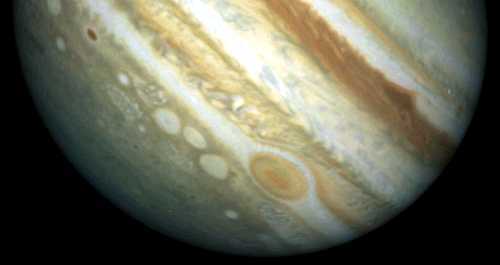
 |
 Jupiter is the fifth planet from the Sun and by far the largest.
Jupiter is more than twice as
massive as all
the other planets combined (318 times Earth).
Jupiter is the fifth planet from the Sun and by far the largest.
Jupiter is more than twice as
massive as all
the other planets combined (318 times Earth).
orbit: 778,330,000 km (5.20 AU) from Sun
diameter: 142,984 km (equatorial)
mass: 1.900e27 kg
Jupiter (a.k.a. Jove; Greek
Zeus)
was the King of the Gods, the ruler
of Olympus and the patron of the Roman state.
Zeus was the son of Cronus (Saturn).
Jupiter is the fourth brightest object in the sky (after the Sun, the Moon and Venus; at some times Mars is also brighter). It has been known since prehistoric times. Galileo's discovery, in 1610, of Jupiter's four large moons Io, Europa, Ganymede and Callisto (now known as the Galilean moons) was the first discovery of a center of motion not apparently centered on the Earth. It was a major point in favor of Copernicus's heliocentric theory of the motions of the planets; Galileo's outspoken support of the Copernican theory got him arrested by the Inquisition. He was forced to recant his beliefs and was imprisoned for the rest of his life.
Jupiter was first visited by Pioneer 10 in 1973 and later by Pioneer 11, Voyager 1, Voyager 2 and Ulysses. The spacecraft Galileo is currently in orbit around Jupiter and will be sending back data for at least the next two years.
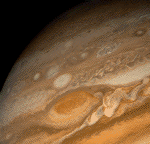 The gas planets
do not have solid surfaces, their gaseous material simply gets
denser with depth
(the radii and diameters quoted for the planets are for levels
corresponding to a pressure of 1
atmosphere).
What we see when looking at these planets is the tops of clouds
high in their atmospheres (slightly above the 1 atmosphere level).
The gas planets
do not have solid surfaces, their gaseous material simply gets
denser with depth
(the radii and diameters quoted for the planets are for levels
corresponding to a pressure of 1
atmosphere).
What we see when looking at these planets is the tops of clouds
high in their atmospheres (slightly above the 1 atmosphere level).
Jupiter is about 90% hydrogen and 10% helium (by numbers of atoms, 75/25% by mass) with traces of methane, water, ammonia and "rock". This is very close to the composition of the primordial Solar Nebula from which the entire solar system was formed. Saturn has a similar composition, but Uranus and Neptune have much less hydrogen and helium.
Our knowledge of the interior of Jupiter (and the other gas planets) is highly indirect and likely to remain so for some time. (The data from Galileo's atmospheric probe goes down only about 150 km below the cloud tops.)
Jupiter probably has a core of rocky material amounting to something like 10 to 15 Earth-masses.
Above the core lies the main bulk of the planet in the form of liquid metallic hydrogen. This exotic form of the most common of elements is possible only at pressures exceeding 4 million bars, as is the case in the interior of Jupiter (and Saturn). Liquid metallic hydrogen consists of ionized protons and electrons (like the interior of the Sun but at a far lower temperature). At the temperature and pressure of Jupiter's interior hydrogen is a liquid, not a gas. It is an electrical conductor and the source of Jupiter's magnetic field. This layer probably also contains some helium and traces of various "ices".
The outermost layer is composed primarily of ordinary molecular hydrogen and helium which is liquid in the interior and gaseous further out. The atmosphere we see is just the very top of this deep layer. Water, carbon dioxide, methane and other simple molecules are also present in tiny amounts.
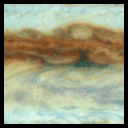 Three distinct layers of clouds
are believed to exist consisting of ammonia ice, ammonium
hydrosulfide and a mixture of ice and water. However, the
preliminary
results
from the Galileo probe show only faint indications of clouds (one instrument
seems to have detected the topmost layer while another may have
seen the second).
But the probe's entry point (left) was unusual --
Earth-based telescopic observations and more
recent
observations
by the Galileo orbiter suggest that the probe entry site
may well have been one of the warmest and least cloudy areas on
Jupiter at that time.
Three distinct layers of clouds
are believed to exist consisting of ammonia ice, ammonium
hydrosulfide and a mixture of ice and water. However, the
preliminary
results
from the Galileo probe show only faint indications of clouds (one instrument
seems to have detected the topmost layer while another may have
seen the second).
But the probe's entry point (left) was unusual --
Earth-based telescopic observations and more
recent
observations
by the Galileo orbiter suggest that the probe entry site
may well have been one of the warmest and least cloudy areas on
Jupiter at that time.
Data from the Galileo atmospheric probe also indicate that there is much less water than expected. The expectation was that Jupiter's atmosphere would contain about twice the amount of oxygen (combined with the abundant hydrogen to make water) as the Sun. But it now appears that the actual concentration much less than the Sun's. Also surprising was the high temperature and density of the uppermost parts of the atmosphere.
 Jupiter and the other gas planets have
high velocity winds which are confined in wide bands of
latitude. The winds blow in opposite directions in adjacent bands.
Slight chemical and temperature differences between these bands
are responsible for the colored
bands that dominate the planet's appearance.
The light colored bands are called zones; the dark ones belts.
The bands have been known
for some time on Jupiter, but the
complex vortices in the boundary regions between the bands were
first seen by Voyager.
The data from the Galileo probe indicate that the winds are even
faster than expected (more than 400 mph) and extend down into as far as
the probe was able to observe;
they may extend down thousands of kilometers into the interior.
Jupiter's atmosphere was also found to be quite turbulent.
This indicates that Jupiter's winds are driven in large part by
its internal heat rather than from solar input as on Earth.
Jupiter and the other gas planets have
high velocity winds which are confined in wide bands of
latitude. The winds blow in opposite directions in adjacent bands.
Slight chemical and temperature differences between these bands
are responsible for the colored
bands that dominate the planet's appearance.
The light colored bands are called zones; the dark ones belts.
The bands have been known
for some time on Jupiter, but the
complex vortices in the boundary regions between the bands were
first seen by Voyager.
The data from the Galileo probe indicate that the winds are even
faster than expected (more than 400 mph) and extend down into as far as
the probe was able to observe;
they may extend down thousands of kilometers into the interior.
Jupiter's atmosphere was also found to be quite turbulent.
This indicates that Jupiter's winds are driven in large part by
its internal heat rather than from solar input as on Earth.
The vivid colors seen in Jupiter's clouds are probably the result of subtle chemical reactions of the trace elements in Jupiter's atmosphere, perhaps involving sulfur whose compounds take on a wide variety of colors, but the details are unknown.
The colors correlate with the cloud's altitude: blue lowest, followed by browns and whites, with reds highest. Sometimes we see the lower layers through holes in the upper ones.
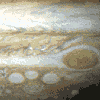 The Great Red Spot (GRS)
has been seen by Earthly observers for more than 300 years
(its discovery is usually attributed to Cassini,
or Robert Hooke in the 17th century).
The GRS is an oval about 12,000 by 25,000 km, big enough to hold two Earths.
Other smaller but similar spots have been known for
decades.
Infrared observations and the direction of its rotation indicate that
the GRS is a high-pressure region whose cloud tops are significantly
higher and colder than the surrounding regions.
Similar structures have been seen on Saturn and
Neptune.
It is not known how such structures can persist for so long.
The Great Red Spot (GRS)
has been seen by Earthly observers for more than 300 years
(its discovery is usually attributed to Cassini,
or Robert Hooke in the 17th century).
The GRS is an oval about 12,000 by 25,000 km, big enough to hold two Earths.
Other smaller but similar spots have been known for
decades.
Infrared observations and the direction of its rotation indicate that
the GRS is a high-pressure region whose cloud tops are significantly
higher and colder than the surrounding regions.
Similar structures have been seen on Saturn and
Neptune.
It is not known how such structures can persist for so long.
Jupiter radiates more energy into space than it receives from the Sun. The interior of Jupiter is hot: the core is probably about 20,000 K. The heat is generated by the Kelvin-Helmholtz mechanism, the slow gravitational compression of the planet. (Jupiter does NOT produce energy by nuclear fusion as in the Sun; it is much too small and hence its interior is too cool to ignite nuclear reactions.) This interior heat probably causes convection deep within Jupiter's liquid layers and is probably responsible for the complex motions we see in the cloud tops. Saturn and Neptune are similar to Jupiter in this respect, but oddly, Uranus is not.
Jupiter is just about as large in diameter as a gas planet can be. If more material were to be added, it would be compressed by gravity such that the overall radius would increase only slightly. A star can be larger only because of its internal (nuclear) heat source. (But Jupiter would have to be at least 80 times more massive to become a star.)
Jupiter has a huge magnetic field, much stronger than Earth's.
Its magnetosphere extends
more than 650 million km (past the orbit of Saturn!). (Note that
Jupiter's magnetosphere is far from spherical -- it extends "only" a few
million kilometers in the direction toward the Sun.)
Jupiter's moons therefore lie within its magnetosphere, a fact which
may partially explain some of the activity on Io.
Unfortunately for future space travelers and of real concern to the designers
of the Voyager and Galileo spacecraft, the environment near Jupiter
contains high levels of energetic particles trapped by Jupiter's magnetic
field. This "radiation" is similar to, but much more intense than, that
found within Earth's Van Allen belts.
It would be immediately fatal to an unprotected human being.
The Galileo atmospheric probe
discovered a new intense radiation belt
between Jupiter's ring and the uppermost atmospheric layers.
This new belt is approximately 10
times as strong as Earth's Van Allen radiation belts.
Surprisingly, this new
belt was also found to contain high energy helium ions of unknown origin.
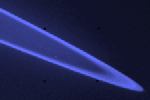 Jupiter has rings like Saturn's, but much fainter and
smaller (right). They were totally
unexpected and were only discovered when two of the Voyager 1
scientists insisted that after traveling 1 billion km it was at
least worth a quick
look to see if any rings might be present. Everyone else thought that the
chance
of finding anything was nil, but there they were. It was a major coup.
They have since been
imaged
in the infra-red from ground-based telescopes and by
Galileo.
Jupiter has rings like Saturn's, but much fainter and
smaller (right). They were totally
unexpected and were only discovered when two of the Voyager 1
scientists insisted that after traveling 1 billion km it was at
least worth a quick
look to see if any rings might be present. Everyone else thought that the
chance
of finding anything was nil, but there they were. It was a major coup.
They have since been
imaged
in the infra-red from ground-based telescopes and by
Galileo.
Unlike Saturn's, Jupiter's rings are dark (albedo about .05). They're probably composed of very small grains of rocky material. Unlike Saturn's rings, they seem to contain no ice.
Particles in Jupiter's rings probably don't stay there for long (due to atmospheric and magnetic drag). Galileo found clear evidence that the rings are continuously resupplied by dust formed by micrometeor impacts on the four inner moons, which are very energetic because of Jupiter's large gravitational field. The inner halo ring is broadened by interactions with Jupiter's magnetic field.
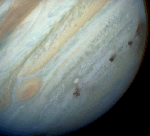 In July 1994, Comet Shoemaker-Levy 9 collided with
Jupiter with spectacular results (left). The effects were clearly visible even with
amateur telescopes. The debris from the
collision was visible for nearly a year afterward with HST.
In July 1994, Comet Shoemaker-Levy 9 collided with
Jupiter with spectacular results (left). The effects were clearly visible even with
amateur telescopes. The debris from the
collision was visible for nearly a year afterward with HST.
When it is in the nighttime sky, Jupiter is often the brightest "star" in the sky
(it is second only to Venus, which is seldom visible in a dark sky).
The four Galilean moons are easily visible with binoculars;
a few bands and the Great Red Spot can be seen with a small astronomical
telescope.
There are several Web sites
that show the current position of Jupiter (and the other planets) in the sky.
More detailed and customized charts can be created with a
planetarium program
such as Starry Night.
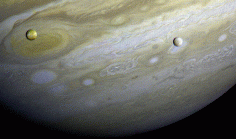 Jupiter has 16 known satellites, the four large
Galilean
moons and 12 small ones.
Jupiter has 16 known satellites, the four large
Galilean
moons and 12 small ones.
Distance Radius Mass Satellite (000 km) (km) (kg) Discoverer Date --------- -------- ------ ------- ---------- ----- Metis 128 20 9.56e16 Synnott 1979 Adrastea 129 10 1.91e16 Jewitt 1979 Amalthea 181 98 7.17e18 Barnard 1892 Thebe 222 50 7.77e17 Synnott 1979 Io 422 1815 8.94e22 Galileo 1610 Europa 671 1569 4.80e22 Galileo 1610 Ganymede 1070 2631 1.48e23 Galileo 1610 Callisto 1883 2400 1.08e23 Galileo 1610 Leda 11094 8 5.68e15 Kowal 1974 Himalia 11480 93 9.56e18 Perrine 1904 Lysithea 11720 18 7.77e16 Nicholson 1938 Elara 11737 38 7.77e17 Perrine 1905 Ananke 21200 15 3.82e16 Nicholson 1951 Carme 22600 20 9.56e16 Nicholson 1938 Pasiphae 23500 25 1.91e17 Melotte 1908 Sinope 23700 18 7.77e16 Nicholson 1914Values for the smaller moons are approximate.
Distance Width Mass Ring (km) (km) (kg) ---- -------- ----- ------ Halo 92000 30500 ? Main 122500 6440 1e13 Gossamer 128940 100000 ?(distance is from Jupiter's center to the ring's inner edge)